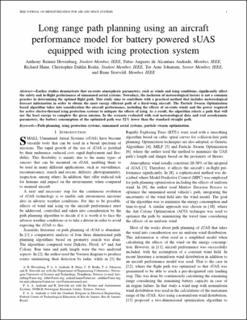| dc.contributor.author | Hovenburg, Anthony Reinier | |
| dc.contributor.author | Andrade, Fabio | |
| dc.contributor.author | Hann, Richard | |
| dc.contributor.author | Rodin, Christopher D | |
| dc.contributor.author | Johansen, Tor Arne | |
| dc.date.accessioned | 2020-11-13T09:27:56Z | |
| dc.date.available | 2020-11-13T09:27:56Z | |
| dc.date.created | 2020-09-07T14:11:28Z | |
| dc.date.issued | 2020 | |
| dc.identifier.citation | IEEE Journal on Miniaturization for Air and Space Systems. 2020, 1 (2), 76 - 89 | en_US |
| dc.identifier.issn | 2576-3164 | |
| dc.identifier.uri | https://hdl.handle.net/11250/2687721 | |
| dc.description.abstract | Earlier studies demonstrate that en-route atmospheric parameters, such as winds and icing conditions, significantly affect the safety, and in-flight performance of unmanned aerial systems. Nowadays, the inclusion of meteorological factors is not a common practice in determining the optimal flight path. This study aims to contribute with a practical method that includes meteorological forecast information in order to obtain the most energy efficient path of a fixed-wing aircraft. The particle swarm optimization-based algorithm takes into consideration the aircraft performance, including the effects of en-route winds and the power required for active electro-thermal icing protection systems to mitigate the effects of icing. As a result, the algorithm selects a path that will use the least energy to complete the given mission. In the scenario evaluated with real meteorological data and real aerodynamic parameters, the battery consumption of the optimized path was 52% lower than the standard straight path. | en_US |
| dc.language.iso | eng | en_US |
| dc.publisher | Institute of Electrical and Electronics Engineers (IEEE) | en_US |
| dc.relation.uri | http://folk.ntnu.no/richahan/Publications/2020_Pathplanning.pdf | |
| dc.title | Long range path planning using an aircraft performance model for battery powered sUAS equipped with icing protection system | en_US |
| dc.type | Journal article | en_US |
| dc.description.version | acceptedVersion | en_US |
| dc.source.pagenumber | 76-89 | en_US |
| dc.source.volume | 1 | en_US |
| dc.source.journal | IEEE Journal on Miniaturization for Air and Space Systems | en_US |
| dc.source.issue | 2 | en_US |
| dc.identifier.doi | 10.1109/JMASS.2020.3003833 | |
| dc.identifier.cristin | 1827812 | |
| dc.relation.project | Regionale forskningsfond Midt-Norge: 285248 | en_US |
| dc.relation.project | Notur/NorStore: NN9613K | en_US |
| dc.relation.project | Norges forskningsråd: 237906 | en_US |
| dc.relation.project | Norges forskningsråd: 223254 | en_US |
| dc.relation.project | EC/H2020/642153 | en_US |
| dc.description.localcode | © 2020 IEEE. Personal use of this material is permitted. Permission from IEEE must be obtained for all other uses, in any current or future media, including reprinting/republishing this material for advertising or promotional purposes, creating new collective works, for resale or redistribution to servers or lists, or reuse of any copyrighted component of this work in other works. | en_US |
| cristin.ispublished | true | |
| cristin.fulltext | postprint | |
| cristin.qualitycode | 0 | |
